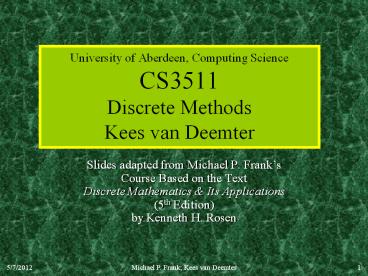University of Aberdeen, Computing Science CS3511 Discrete Methods Kees van Deemter - PowerPoint PPT Presentation
1 / 18
Title:
University of Aberdeen, Computing Science CS3511 Discrete Methods Kees van Deemter
Description:
Book: Ken Rosen, Discrete Mathematics and its Applications. 5th or 6th edition. ... Applicable to just about anything. Some nice puzzles. Highly varied ... – PowerPoint PPT presentation
Number of Views:237
Avg rating:3.0/5.0
Title: University of Aberdeen, Computing Science CS3511 Discrete Methods Kees van Deemter
1
University of Aberdeen, Computing
ScienceCS3511Discrete MethodsKees van Deemter
- Slides adapted from Michael P. Franks Course
Based on the TextDiscrete Mathematics Its
Applications (5th Edition)by Kenneth H. Rosen
2
Practicalities
- Lectures
- Mon 2PM (MT6)
- Tue 11AM (Old Senate Room)
- Practicals
- Tue 1-3PM (MT011)
- Tue 3-5PM (MT011)
- Dont go by this info alone, since things may
change. Consult web page at least twice per week,
and watch email to level3-students
3
Key resources
- Lectures based on Michael Franks slides(Univ.
of Florida) - Were not using all his lectures
- Many changes in those that we do use
- Lectures will appear on the web
- Book Ken Rosen, Discrete Mathematics and its
Applications. 5th or 6th edition. Then e.g. (5th
ed.) - http//www.mhhe.com/math/advmath/rosen/r5
4
Other practical issues
- AssessmentStandard arrangments
- 75 exam
- 25 cont. assessment
- Arguably, this course comes too late in your
curriculum - You will be somewhat familiar with much in this
course - A little knowledge is a dangerous thing
5
Module 0Course Overview
- A few general slides about the subject matter of
this course. - 14 slides, ½ lecture
6
What is Mathematics, really?
- Its not just about numbers!
- Mathematics is much more than that
- These concepts can be about numbers, symbols,
ideas, images, sounds, anything!
Mathematics is, most generally, the study of any
and all certain truths (about any kind of
concepts)
7
Uses of Discrete Math
- Starting from simple structures of logic and set
theory, theories are constructed that capture
aspects of reality - Physics
- Biology (DNA)
- Common-sense reasoning (logic)
- Natural Language (trees, sets, functions, ..)
- Anything that we want to describe precisely
8
So, whats this class about?
- What are discrete structures anyway?
- Discrete (? discreet!) - Composed of
distinct, separable parts. (Opposite of
continuous.) discretecontinuous
digitalanalog - Structures - Objects built up from simpler
objects. - Discrete Mathematics - The mathematical study
of discrete objects and structures.
9
Discrete Mathematics
- When using numbers, were more likely to use N
(natural numbers) and Z (whole numbers) than Q
(fractions) and R (real numbers). - Reason Q and R are densely ordered
- This notion can be defined precisely.
- Some DM notation will help (Notation should
become clear later on.)
10
- ?Q,lt ? is densely ordered because?x?Q ?y?Q
(xlty ? ?z (xltz zlty) ) - (if xlty then there exists at least one z
in between) - Opposite of densely ordereddiscretely ordered
11
- Yet, Q and R can be defined in terms of discrete
concepts (as we have seen) - This means that Discrete Mathematics has no exact
borders - Different books and courses treat different topics
12
Discrete Structures Well Study
- Propositions
- Predicates
- Proofs
- Sets
- Functions
- (Orders of Growth)
- (Algorithms)
- Integers
- (Summations)
- (Sequences)
- Strings
- Permutations
- Combinations
- Relations
- Graphs
- Trees
- (Logic Circuits)
- (Automata)
13
Some relevant notations
14
Discrete Math for computing
- The basis of all of computing is manipulations
of discrete structures represented in memory. - DM is the conceptual foundation for all of
computer science.
15
Some examples
- Algorithms data structures
- Compilers interpreters.
- Formal specification verification
- Databases
- Cryptography
- Digital circuits
- etc.
- DM is relevant for all aspects of computing!
16
Plan of Course (as per Rosen 5th ed.)
- Logic (1.1-4)
- Proof methods (1.5)
- Set theory (1.6-7)
- Functions (1.8)
- (Algorithms (2.1))
- (Orders of Growth (2.2))
- (Complexity (2.3))
- Number theory (2.4-5)
- (Number theory apps. (2.6))
- (Matrices (2.7))
- Proof strategy (3.1)
- (Sequences (3.2))
- (Summations (3.2))
- (Countability (3.2))
- Inductive Proofs (3.3)
- Recursion (3.4-5)
- Program verification (3.6)
- (Combinatorics (ch. 4))
- (Probability (ch. 5))
- (Recurrences (6.1-3))
- Relations (ch. 7)
- Graph Theory (chs. 89)
- (Boolean Algebra (ch. 10))
- (Computing Theory (ch.11))
17
Course Objectives
- Upon completion of this course, the student
should be able to - Check validity of simple logical arguments
(proofs). - Check the correctness of simple algorithms.
- Recognise and construct simple instances of valid
logical arguments and correct algorithms. - Describe the definitions and properties of a
variety of specific types of discrete structures. - Correctly read, represent and analyze various
types of discrete structures using standard
notations. - Preparation for CS4026, Formal Models
18
Have Fun!
- Many people find Discrete Mathematics more
enjoyable than, for example, Analysis - Applicable to just about anything
- Some nice puzzles
- Highly varied































